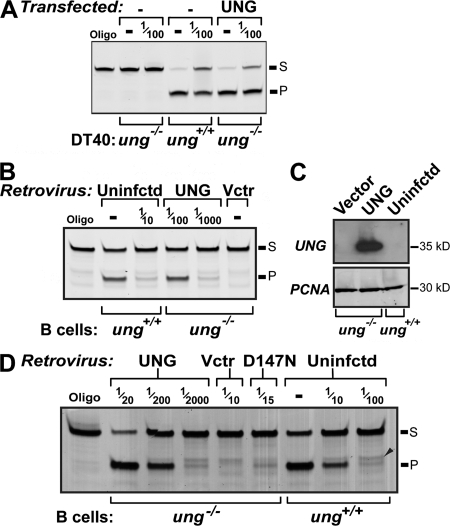Figure 4.
Comparison of endogenous UNG expression with that achieved after gene delivery. (A) uracil-excision activity in whole-cell extracts of pIRES-hygro[FLAG-UNG] transfectants of ung−/− DT40 as compared with that in parental ung+/+ DT40. Extracts were assayed undiluted or with a 10−2 dilution, as indicated. (B) Uracil-excision activity in extracts of B cells from either wild-type (ung+/+) mice or from ung−/− mice that have been transduced with pMX-UNG (UNG) or empty pMX retroviral vector (Vctr). The nominal dilutions of the extracts used are indicated, and have been normalized according to the percentage of GFP+ cells to control for differences in the efficiency of retroviral transduction. (C) UNG expression monitored by Western blot in whole-cell extracts of B cells from ung+/+ or ung−/− mice that had been transduced with either pMX-UNG or empty vector and cultured for 3 d. The filters were subsequently stripped and reprobed with an anti-PCNA antibody to provide a loading control. (D) Uracil-excision activity in extracts of B cells from ung−/− mice that have been transduced with retroviral vectors expressing wild-type or D147N UNG as compared with that in extracts of (LPS + IL4)-activated B cells from wild-type (ung+/+) mice. The nominal dilutions of the extracts used are indicated, normalized as in B. A minor band whose migration position (arrowhead) is slightly slower than the canonical oligonucleotide deamination product (P) reflects a weak activity in the extracts, which cleaves the substrate oligonucleotide just 5′ of the target uracil; after uracil excision, this minor band disappears, comigrating with the product P.

